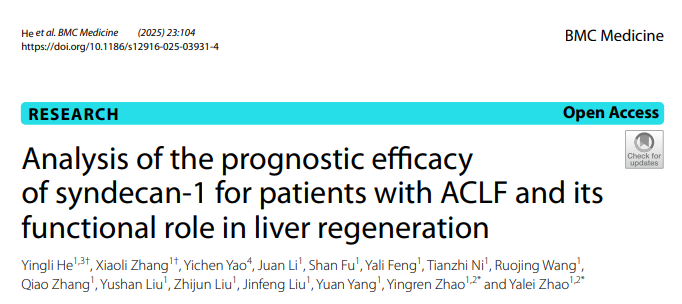Liver regeneration dysfunction is a key feature of acute-on-chronic liver failure (ACLF). Accurately predicting the prognosis of ACLF patients and promoting liver regeneration are urgent challenges that need to be addressed.
Recently, Dr. Zhao Yalei from the team of Professor He Yingli in the Department of Infectious Diseases of Xi'an Jiaotong University (XJTU) published a paper in BMC Medicine titled "Analysis of the prognostic efficacy of syndecan-1for patients with ACLF and its functional role in liver regeneration". The study demonstrates that serum Syndecan-1 can serve as a prognostic biomarker for ACLF, and the newly developed prognostic scoring model, UIAS, based on Syndecan-1, shows excellent predictive efficacy. Furthermore, liver cell Syndecan-1 is closely related to ACLF liver regeneration. The journal has a 5-year impact factor of approx. 9.0, marking another significant research achievement for the Department of Infectious Diseases following the publication of six articles with impact factors over 10 last year.

Syndecan-1 is a critical component of the glycocalyx on the surface of epithelial and endothelial cells—a heparan sulfate proteoglycan. Its extracellular domain connects with three heparan sulfate (HS) chains. In cases of infection or injury, Syndecan-1 can shed from the cell surface into the circulation. By measuring the level of Syndecan-1 in the circulation, the severity of the disease can be reflected, making it an ideal prognostic biomarker. However, its role in ACLF remains unclear.
The study showed that the baseline serum Syndecan-1 levels in ACLF patients upon admission were significantly higher than those in healthy controls, chronic hepatitis B patients, and cirrhosis patients, and the levels in the 90-day non-survival group were significantly higher than those in the survival group. A new ACLF prognostic scoring system, UIAS, was developed based on Syndecan-1 (UIAS = 0.076 × Age + 0.001 × Syndecan-1 + 1.454 × INR + 2.854 × Upper Gastrointestinal Bleeding (UGIB) - 12.165; for patients without UGIB,UGIB = 1; for patients with UGIB, UGIB = 2). In this study population, the UIAS score showed better predictive ability for 28-day disease progression and 90-day mortality compared to the Child-Pugh, MELD, and COSSH-ACLF II scores. In a validation cohort of HBV-ACLF patients based on COSSH diagnostic criteria, the UIAS score predicted 28-day disease progression better than Child-Pugh and MELD scores, was comparable to the COSSH-ACLF II score, and predicted 90-day mortality better than all three.
Additionally, the study revealed that liver cell Syndecan-1 is closely related to ACLF liver regeneration and could serve as a potential therapeutic target. Targeting Syndecan-1 may promote liver regeneration through the JAK1/STAT3 pathway, thereby improving ACLF.
The study showed that sulodexide and HS can promote liver regeneration and exert anti-apoptotic effects through the JAK1/STAT3 pathway.